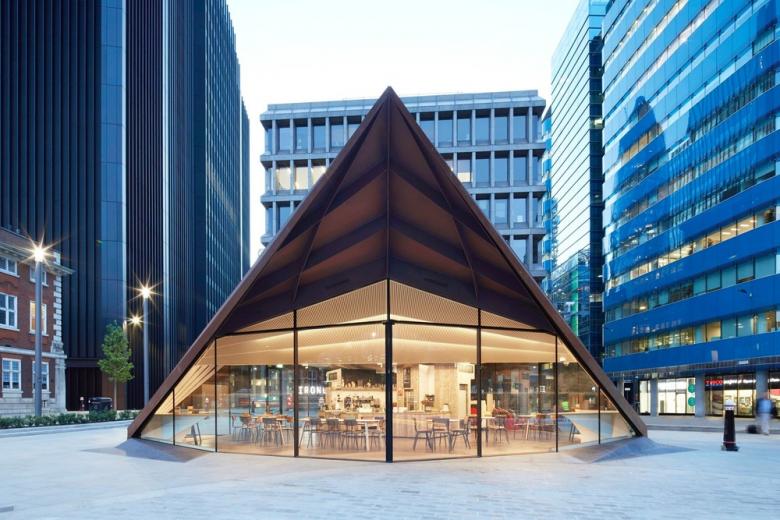Make Architects
Portsoken Pavilion
Make Architects
13. juli 2018
Photo: Make Architects (All photographs courtesy of v2com)
Portsoken Pavilion, a sculptural monocoque structure by Make Architects, has been unveiled as part of the City of London Corporation’s transformation of a former gyratory into a high-quality public space.
Project: Portsoken Pavilion, 2018
Location: London, England
Client: The City of London
Architect: Make Architects
Team: Aecom, Air3, Cantifix Glazing, Fluid Structures, Kier, Littlehampton Welding
Portsoken Pavilion is the centerpiece structure for the new Aldgate Square. (Photo: Make Architects)
The former complex roundabout, with its series of pedestrian subways, has been the subject of intense development for over six years to reroute roads, block off unsafe subways and transform the area into the new Aldgate Square — one of the largest public spaces in London’s Square Mile.
The structure is uplit at night so that the internal white soffit makes the pavilion glow. (Photo: Make Architects)
The pavilion, which will be run by local social enterprise Kahaila as a café and multifunctional community space, sits proudly in this new landscape, delivering a public amenity as well as improving the connection between the two distinctive listed heritage buildings that sit either side of the new square: the St Botolph Without Aldgate church and Sir John Cass’s Foundation Primary School.
Portsoken Pavilion tonally links to the nearby heritage structures. (Photo: Make Architects)
It is the second in a series of pavilions planned by the City of London Corporation and was required to have an aesthetic relationship with the first, RIBA Award-winning pavilion, the City of London Information Centre adjacent to St Paul’s Cathedral, which was completed by Make in 2008.
Portsoken Pavilion is an important community amenity. (Photo: Make Architects)
This latest pavilion picks up on the asymmetrical angles of the City of London Information Centre with an angular structure that folds down to meet the ground at just three triangular support points, with glazing in between. Corten cladding panels form a rigid structural skin covering the pavilion and create a faceted surface that reduces the overall profile of the pavilion and provides its character. The channels created by the layered cladding are also functional, allowing the rainwater to run down them into discreet drains located where the steel meets the Yorkstone paving. The warm tones of the weathered steel chime with the brown brick of the Grade I-listed church and the red brick Grade II-listed primary school. Over time the steel will darken and provide an earthy, complementary counterpoint.
The angles evoke the precedent of the City of London Information Centre - an important part of the client brief. (Photo: Make Architects)
Designed parametrically, the pavilion’s form has been carefully designed with respect to key pedestrian approaches to the new square. As such, it has no backside, and its three glazed elevations face Duke’s Place to the northwest, Houndsditch and St Botolph Street to the northeast, and the new square and Aldgate High Street to the south. These elevations provide clear views into and through the structure and deliver natural surveillance, as well as entrances into the pavilion on all sides.
The internal soffit mimics the external form. (Photo: Make Architects)
The 325 sq m building is a single-story, above-ground but has utilized part of the former subways to accommodate a basement level for plant, back-of-house facilities, kitchens and toilets. This has significantly reduced the quantity of land that was needed above ground and therefore delivered more public space for the gardens.
The internal soffit picks up on the external geometry. (Photo: Make Architects)
The constant temperature of the concrete tunnels also works to help regulate the temperature of the building: air is drawn through the tunnels and up into the café, heating in the winter or cooling in the summer. The large overhangs on the roof were also attuned to the orientation of the sun and provide solar shading to the interior at peak times of the day.
Two rooflights are positioned over the counter. (Photo: Make Architects)
The entire structure was prefabricated off-site by Littlehampton Welding and then taken apart and allowed to rust while the site was prepared by contractor Kier. It was brought into site in pieces and reassembled and welded in situ. After the structure was in place and all the on-site structural welds complete, the underside of the steelwork that would form the internal space was sprayed with 150 mm of insulation to minimize heat loss and remove the possibility of condensation forming on the internal face of the steelwork.
Natural surveillance (Photo: Make Architects)
Stairs leading down to back-of-house facilities that have been created in the former subways. (Photo: Make Architects)
Initial sketches (Drawing: Make Architects)
Gerelateerde artikelen
-
Portsoken Pavilion
on 13-07-2018
-
Rathbone Square
on 16-04-2018











